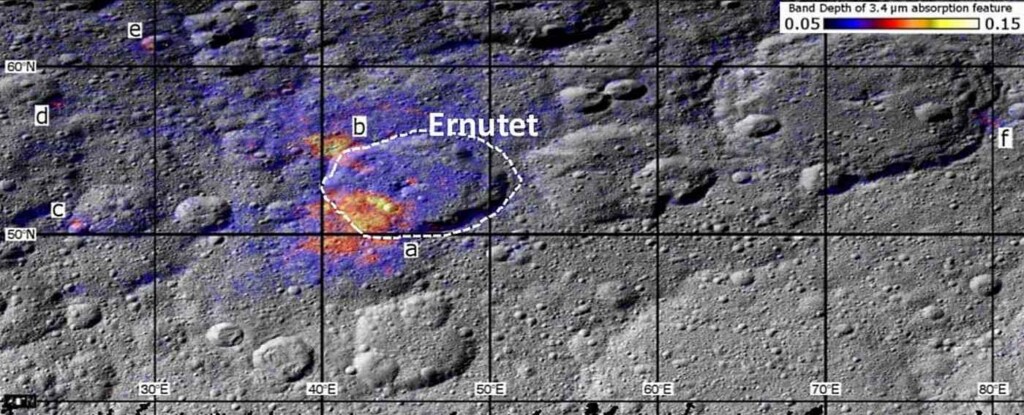
In 2017, NASA’s Dawn spacecraft sent data back to Earth from the dwarf planet Ceres, located in our solar system’s main asteroid belt, that the body contained deposits of organic compounds.
At first, it was hypothesized that these were deposited by comet or asteroid impact, but a new analysis of the data has suggested that, in fact, these deposits are far more likely to originate within the planet itself, putting it suddenly and dramatically within the most likely candidates to host evidence of life beyond Earth.
Though exciting, it’s potentially less of a surprise than if such evidence were found elsewhere; Ceres is a water-rich body with potential geologic activity, both believed to be prerequisites for life. Debate and study about its origin and evolution are both extensive and inconclusive.
Researchers at the Instituto de Astrofísica de Andalucía (IAA-CSIC) looked back over the data from 2017 when organic compounds were detected in Ceres’ Ernutet Crater and discovered an additional 11 regions where similar organics are located.
“The significance of this discovery lies in the fact that, if these are endogenous materials, it would confirm the existence of internal energy sources that could support biological processes,” explains Juan Luis Rizos, a researcher at IAA-CSIC and the study’s lead author.
“Ceres will play a key role in future space exploration. Its water, present as ice and possibly as liquid beneath the surface, makes it an intriguing location for resource exploration,” Rizos told Sci-Tech Daily. “In the context of space colonization, Ceres could serve as a stopover or resource base for future missions to Mars or beyond.”
Ceres is the second-wettest planetary object in the inner solar system behind only Earth.
To make the discovery, the team at IAA used a combination of the Dawn Mission’s instruments to examine a particular area. First, they scanned the whole of the planet with a camera that possessed a high spatial, but low spectral resolution. With it they identified where to look more carefully—a region between the Urvara and Yalode basins.
OTHER SPACE BREAKTHROUGHS: Thrilled Astronomers in Chile Are First to Photograph a Moon-forming Disc Around an Exoplanet
They then examined with a camera that had high spectral, but low spatial resolution, and found evidence of the organic molecules. Their distribution in the region hinted at an ejection event which must have followed the impacts that created the basins.

These were much larger than any in Ceres’ history, catapulting material—in this case potentially organic material—from deep within the dwarf planet to the surface.
If a future spacecraft or telescope can confirm that they are organic in nature, then it would virtually confirm that Ceres is producing these organic compounds endogenously and would then probably be the best place to look for life in our solar system, as the shelter of the planet’s crust would protect water and life from solar radiation.
ANOTHER OCEAN WORLD: NASA Just Found an Ocean World with Atmosphere–The Best Place to Look for Life in Our Galaxy
“The idea of an organic reservoir in such a remote and seemingly inert location like Ceres raises the possibility that similar conditions could exist on other Solar System bodies. Without a doubt, Ceres will be revisited by new probes in the near future, and our research will be key in defining the observational strategy for these missions,” concludes the lead author of the paper.
SHARE This Little-Known Planet And Its Big Potential With Your Friends…




















